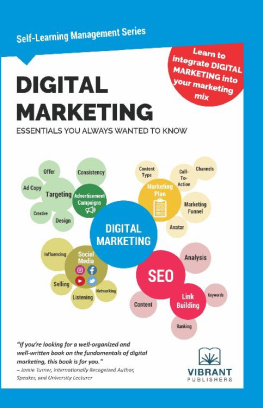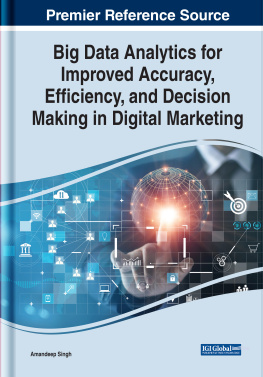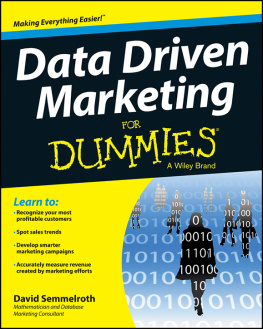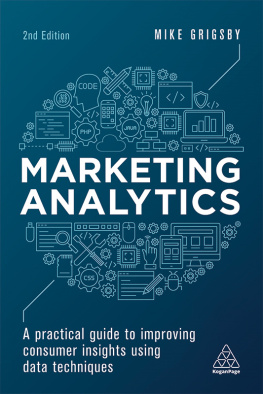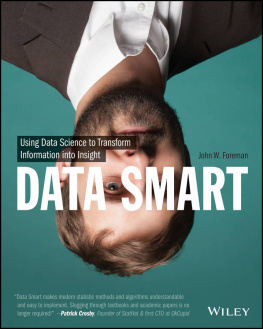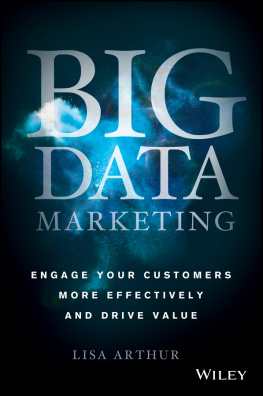
Note on the Ebook Edition
For an optimal reading experience, please view large tables and figures in landscape mode.
This ebook published in 2015 by
Kogan Page Limited
2nd Floor, 45 Gee Street
London EC1V 3RS
United Kingdom
www.koganpage.com
Colin Strong, 2015
E-ISBN 978 0 7494 7212 2
CONTENTS
I t will not have gone unnoticed by anyone involved in big data that the debate about it has become increasingly polarized. On the one hand there are strong advocates of its value who see it as fundamentally changing not only how we do business but the way in which science and indeed the world we inhabit is organized. At the other end of the spectrum are sceptics who consider it is over-hyped and does not fundamentally change anything.
This book contributes to the debate because it is concerned with the way in which brands use big data for marketing purposes. As such it is a book about human beings our ability to make sense of data, to derive new meanings from it and our experience of living in a data-mediated world. There is inevitably spill-over into other areas but that is what the core of this book is about. Much of what the book contains will be relevant to non-profit organizations and government agencies but for the sake of simplicity the key point of reference is to brands.
Of course, the case for big data has, at times, inevitably been somewhat overstated. Technologists are generally the most guilty of this, with their perspective often being infused with a sense that if only we can reduce all human behaviour to a series of data points then we will be able to predict much of our future activity. This reductionist view of human behaviour fails to recognize the complexity of the world in which we live, the subtle eco-systems we inhabit and the context in which behaviours take place. A reductionist use of big data, certainly in the context of personal data, means that the marketing profession is in danger of reducing its remit, becoming a tactical rather than strategic part of the organization.
The sceptics on the other hand are not seeing the case for the potential value that lies in big data. We have a massive resource available to us that tracks our behaviours in a manner so thorough, so intimate and so consistent that it is hard not to see that there must surely be gold in those hills. The question is what is it and how do we find a way to get it?
This book is about how marketers can recapture the big data agenda, wrestling it away from technologists and reasserting a more strategic viewpoint. Doing so will surely reinvigorate the marketing profession. Understanding data relating to human behaviour is a long-standing skill of marketers and social scientists. We are starting to see that many of their practitioner skills that help us read and interpret data are just as valid in a big data world. New challenges are of course thrown up but this just means that we need to think about these issues in original ways.
We can derive so much from our data trails yet a lot of the analysis and interpretation remains at a pretty basic behavioural level. As brands struggle to find differentiation in a world where technology reduces their ability to stand out from the competition, then this creates an opportunity. Human behaviour is complex but big data offers new ways to understand that complexity. And complexity should be the friend of the marketer as this provides opportunities to find differences to leverage.
Social scientists are often ahead of brands on exploiting the opportunities that can be found in big data. New fields such as cyber psychology, computational sociology and cultural analytics are emerging which make good use of big data and heightened computing power to generate new insights into human behaviour. It is to these new fields that brands can look to find new ways to search for meaning in the morass of data.
And in the midst of all this we cannot forget the experience of the consumer. For it is the consumer that is producing this data but also then being the recipient of activities borne from that very data. Is the consumer a willing participant in this? We need to explore the ways consumers understand their experience as these issues, such as privacy and empowerment, are themselves rapidly becoming a source of differentiation for brands.
This book is not a detailed how to book, although there is hopefully a lot of useful guidance contained within it. Rather it is a call to arms to seize the opportunity to see how big data can be used to understand consumers in new and exciting ways. At its heart is the point that in order to be smart about big data, we really need to understand humans. We cannot interpret data without understanding the pitfalls we can potentially fall into in the process. We need frameworks of behaviour to help us explore data sets. We need to understand how humans react to data-mediated environments to understand how brands can best implement data strategies.
The book is a manifesto for brands to think differently about data. In the process you may start to see humans differently. It is designed to set people thinking and spark debate. Thank you for picking this up and being part of that.
T here are a number of people and organizations that I need to thank for their support. First, my wife Joanne, for her support and her inspiration across the breadth of topics in the book. Second, I would like to thank my colleagues and friends who have discussed and reviewed the material and thinking with me. Particular thanks are owed to Dr Guy Champniss, Stuart Crawford Browne, Ryan Garner, Alan Mitchell, Corrine Moy, Anders Nielsen, Simon Pulman Jones and Iain Stanfield.
I am also very grateful to Henry Stuart Publications for allowing me to use a version of a paper that appeared in Applied Marketing Analytics for . My thanks to Stuart Crawford Browne for the contributions he made to earlier versions of the book.
To Joanne, although she would have preferred a book of love sonnets.
T hroughout history, mankinds progress has been driven by our ability to devise new technologies. Agriculture is a good example. Between the 8th and the 18th centuries, the technology involved in farming more or less stayed the same and few advances were achieved. So a UK farmer in the 18th century was effectively using the same kit as a farmer in Julius Caesars day.
Then in the mid-1700s James Small created the first effective single-furrow horse plough, which hugely increased efficiency. A number of other advances were made at that time, such as Jethro Tulls seed drill. These had a major impact on the UKs ability to support a growing population, which grew to record levels. This, in turn, led to greater demand for goods and services as well as a new class of landless labourer, effectively creating the conditions for the Industrial Revolution.
Technology, as Nicolas Carr points out in his excellent book, The Shallows , reflects and shapes the way in which we understand the world. For instance, the mechanical clock changed the way we saw ourselves. The clock defined time in terms of units of equal duration, so we were able to start comprehending the concepts of division and measurement. We began to see, in the world around us, how the whole is composed of individual pieces that are in turn themselves composed of pieces. We began to understand that there are abstract patterns behind the visible appearance of the material world. And this mindset effectively propelled us out of the Middle Ages, into the Renaissance and then the Enlightenment.
Next page

